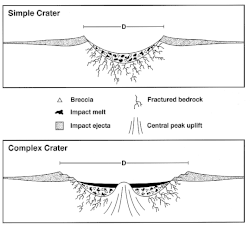Burckle Crater
The Burckle crater is an undersea feature about 29 kilometres (18 mi; 16 nmi) in diameter,[1] in the southwestern Indian Ocean.
| Burckle crater | |
|---|---|
 Burckle crater Location of Burckle Crater in the Indian Ocean | |
| Impact crater/structure | |
| Confidence | Hypothesized, contested |
| Diameter | ~29 km (18 mi; 16 nmi) |
| Depth | 3,800 m (12,500 ft) |
| Age | ~5000 years (Holocene) |
| Exposed | No |
| Drilled | No |
| Bolide type | Unknown, possibly remains of a comet |
| Location | |
| Coordinates | 30.865°S 61.365°E |
The Russian Academy of Sciences lists the feature as a potential impact crater.[2] The Holocene Impact Working Group (HIWG)[3] propose that it was formed by a very large-scale and relatively recent (c. 3000–2800 BCE) meteorite impact event, possibly resulting from a comet. These claims have not been accepted by the scientific community.
Description
The feature is located east of Madagascar and west of Western Australia in the southern Indian ocean, adjacent to the SW Indian Ocean Ridge. Its position was determined in 2006 by the Holocene Impact Working Group using prehistoric chevron dune formations in Australia and Madagascar. Based on the hypothesis these dunes were formed by a megatsunami resulting from an impact, the researchers were able to triangulate the location of Burckle crater. The hypothesis that these chevron dunes were caused by a megatsunami has been challenged by geologists Jody Bourgeois and R. Weiss in 2009. Using a computer model to simulate a tsunami, they argue that the structures are more consistent with aeolian processes.[4] The tsunami origin of these chevrons is also disputed by other Earth scientists.[5]
Burckle crater is located at 30.865°S 61.365°E in the Indian Ocean and is 3,800 metres (12,500 ft) below the surface.
See also
References
- Abbott et al., 2006
- Mikheeva, 2017
- "Holocene Impact Working Group (HIWG)". Retrieved 2020-01-26.
- Bourgeois & Weiss, 2009
- Pinter & Ishman, 2008, p.37
Bibliography
- Abbott, D.H.; S.N. Martos; H.D. Elkinton; E.F. Bryant; V. Gusiakov, and D. Breger. 2006. Impact craters as sources of megatsunami generated chevron dunes. Geological Society of America Abstracts with Programs 38. 299. Accessed 2019-02-25.
- Abbott, D.H.; P. Gerard-Little; S. Costa, and D. Breger. 2009. Odd (CaCO3) from the Southwest Indian Ocean near Burckle Crater candidate; impact ejecta or hydrothermal precipitate?. Abstracts of Papers Submitted to the Lunar and Planetary Science Conference, Houston, Texas, abstract 2243 40. 1–2. Accessed 2019-02-25.
- Bourgeois, J., and R. Weiss. 2009. 'Chevrons' are not mega-tsunami deposits; a sedimentologic assessment. Geology 37. 403–406. Accessed 2019-02-25.
- Mikheeva, Anna. 2017. The Complete Catalog of the Earth's Impact structures, 1. Russian Academy of Sciences. Accessed 2019-04-02.
- Pinter, N., and S.E. Ishman. 2008. Impacts, mega-tsunami, and other extraordinary claims. GSA Today 18. 37–38. Accessed 2019-02-25.
External links
- Anonymous (2009) Past Tsunamis? Contrary To Recent Hypothesis, 'Chevrons' Are Not Evidence Of Megatsunamis. ScienceDaily, April 30, 2009.
- Colvin, M. (2006) Researchers claim link between tsunamis and outer space." ABC News, Australia (Transcript of ABC interview with Ted Bryant) November 14, 2006.

